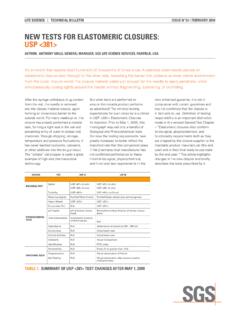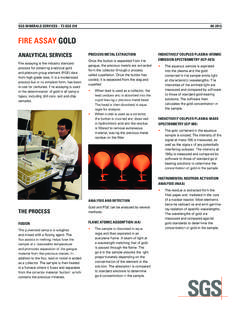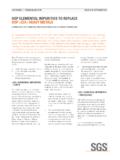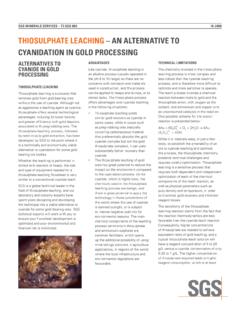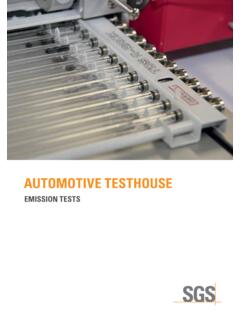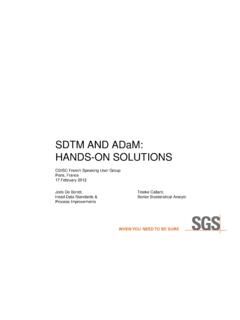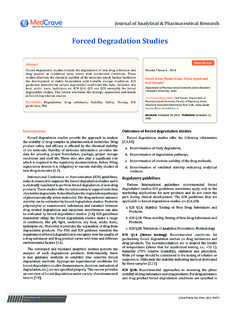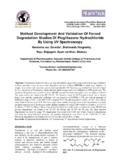Transcription of HOW TO APPROACH A FORCED DEGRADATION …
1 AUTHOR: DR. HILDEGARD BR MMER, CUSTOMER SERVICE MANAGER, SGS LIFE SCIENCE SERVICES, BERLIN, GERMANYHOW TO APPROACH A FORCED DEGRADATION STUDYLIFE SCIENCE I TECHNICAL BULLETINISSUE N 31 / JANUARY 2011 The stability of a drug product or a drug substance is a critical parameter which may affect purity, potency and safety. Changes in drug stability can risk patient safety by formation of a toxic DEGRADATION product(s) or deliver a lower dose than expected. Therefore it is essential to know the purity profile and behaviour of a drug substance under various environmental DEGRADATION studies are carried out for the following reasons: To develop and validate a stability indicating method To determine DEGRADATION path-ways of drug substances and drug products ( , during development phase) To identify impurities related to drug substances or excipients To understand the drug molecule chemistry To generate more stable formula-tions To generate a DEGRADATION pro-file that mimics what would be observed in a formal stability study under ICH conditions To solve stability-related problems ( , mass balance)In order to monitor possible changes to a product over time, the applied analytical method (in most cases a chromatogra-phic method)
2 Must be best case for testing the suitability of a method is using real-time stability samples containing all relevant degra-dation products that might occur. But due to product development timelines, process characteristics, excipients, and other environmental factors, a FORCED DEGRADATION study (stress test) can serve as an a typical study, relevant stress condi-tions are light, heat, humidity, hydrolysis (acid / base influence) and oxidation or even a combination of described parame-ters. If it is necessary to form degra-dation products, the strength of stress conditions can vary due to the chemical structure of the drug substance, the kind of drug product, and product specific storage requirements. An individual pro-gram has to be set up in order to reach a target DEGRADATION of 5 to 20%.
3 A higher level of DEGRADATION will be out of the scope of product stability requirements and therefore unrealistic. The scope of the test is to generate DEGRADATION products in order to facilitate a method development for determination of the relevant , samples will be stressed in a solid form and/or in solution. Typi-cally, stress tests are carried out on one batch of material. For drug products the placebo should be stressed in a similar way in order to exclude those impurities that are not DEGRADATION products ( impurities arising from excipients). Table 1 shows typical stress conditions of API and drug that are poorly soluble in water can be conducted either in suspen-sion or in solution using inert organic co-solvents ( , DMSO, acetic acid or propionic acid).
4 It is important to avoid co-solvents that may be reactive with the drug or complicate analysis ( by LC-MS).X. recommended; (-) not testedSTRESS CONDITION EXAMPLESAPIDRUG PRODUCTSOLIDSOLUTION / SUSPENSIONSOLIDSOLUTION / to X H2O2 X XLIGHT1200 Lux hXXXXTEMPERATURE10 C to 70 CXXXXTEMPERATURE / HUMIDITY10 C to 70 C and 60 to 90 X TABLE 1: TYPICAL STRESS CONDITIONS OF API & drug PRODUCTSLIFE SCIENCE I TECHNICAL BULLETIN2A typical study design should be able to cover different stress conditions using different time periods in order to assess the DEGRADATION kinetics. The following table documents a typical stress design. Testing of samples can be performed at defined sampling points using the new method.
5 The specificity of method will be documented and mass balance calcula-ted. Specificity of method for the active ingredient can be established by peak purity experiments using LC-UV, LC-MS or other suitable methods. Investigation of mass balance in stress samples show the suitability of analytical method to examine for DEGRADATION products. Usual-ly 100% should be reached by adding assay value and levels of DEGRADATION products. If 100%-level is not achieved, efforts to account for the missing mass should be made response factors, formation of volatiles or retained impu-rities. Depending on method precision, a variation between 97 to 104 % can be upon the product, a specific design will be chosen. An example of a stress study performed on a semi-solid formulation containing a preservative and a hormone as active ingredient is outli-ned in Table 2.
6 In this example, the active ingredient is specified within European Pharmacopoeia and six known impurities (A to F) are stress study was performed using the design described in Table 3. In addition to a batch of drug product, the stress test was also performed on a pla-cebo (containing preservative), and the stressed samples were tested for assay and purity. Procedurally, the samples that are being stressed for the latest time period are analyzed first. Peak purity was checked (match >900), and results were compared to a stressed placebo and an unstressed sample and relevant impurity selected. For a UV-match factor, the cor-relation of a spectrum at peak maximum and at beginning and end of a peak will be tested.
7 In the case of a 100% match, a match factor of 1000 will be the result. For mass spectra, the distance between masses and the relative height of a mass peak will be tested. A match factor of 1000 documents a perfect correlation. The results of main components formed under the stressed conditions for both placebo and drug product are summa-rized in Table 4 and Table on the results of the stress test, a high number of impurities were formed in sample as well as in placebo solutions within the tested period of of placebo containing preserva-tive lead to a high number of different im-purities regarding an unstressed placebo. The amount of preservative decreased mainly by influence of oxidation, light and acid.
8 Mass balance of preservative shows almost 100%.The active ingredient remains almost stable within tested period. Some known impurities rose to a level of about 2% and one unknown component was detected at a higher level. Consequently, this component was the reason that mass balance rises to a level above 105%. Identification of peaks was per-formed using LC-MS and the unknown component was identified to be a degra-PARAMETER24H / 1 DAY3 DAYS7 DAYS14 DAYS28 DAYSLIGHTXHEAT, 70 CXXXXOXIDATION (3%)X1 M HCL (pH )XXX1 M NaOH (pH )XXXTABLE 3: STRESS STUDY FOR HORMONE EXAMPLESTRESS CONDITIONEXAMPLESDRUG SUBSTANCEDRUG PRODUCTPRODUCT to days24 to 48h24 to H2O2few hours to 7 days24 to 48h24 to 48hLIGHT1200 Lux h>48h>48h>48hTEMPERATURE10 C to 70 Cup to 2 weeksup to 3 weeksup to 3 weeksTEMPERATURE / HUMIDITY10 C to 70 C and 60 to 90 to 2 weeksup to 3 weeksup to 3 weeksTABLE 2: TYPICAL STRESS STUDY DESIGNLIFE SCIENCE I TECHNICAL BULLETIN3 TABLE 4.
9 RESULTS - drug PRODUCT* Peak was related to be a DEGRADATION product of PRODUCTDRUG PRODUCTDRUG PRODUCTDRUG PRODUCTDRUG PRODUCTDRUG PRODUCTUNSTRESSEDOXIDATIONLIGHT STRESS70 HCL24H24H28 DAYS7 DAYS7 DAYS[%][%][%][%][%][%]API100102102100969 4 UNKNOWN 1* OF OTHER UNKNOWN PEAKS (<10%) 2531 MASS BALANCE API10110310610610096 TABLE 5: RESULTS - PLACEBONAMEDRUG PRODUCTDRUG PRODUCTDRUG PRODUCTDRUG PRODUCTDRUG PRODUCTDRUG PRODUCTUNSTRESSEDOXIDATIONLIGHT STRESS70 HCL24H24H28 DAYS7 DAYS7 DAYS[%][%][%][%][%][%]PRESERVATIVE993339 849657 UNKNOWN P 1 16 UNKNOWN P2 17 UNKNOWN P3 10 UNKNOWN P4 37 UNKNOWN P5 TOTAL UNKNOWN OTHER (<10%) 35451744 MASS BALANCEPRESERVATIVE9910110410110098 LIFE SCIENCE I TECHNICAL BULLETIN4 CONTACT INFORMATIONTo receive future articles on current trends and regulatory updates, subscribe to SGS Life Science News at +32 10 42 11 (PARIS)+33 1 41 06 95 FRANCE (POITIERS)+33 (0) 5 49 57 04 GERMANY (BERLIN)+49 30 3460 (FREIBURG)+49 761 6116 (TAUNUSSTEIN)+49 6128 744 (GENEVA)
10 +41 22 794 (WOKINGHAM)+44 (0) 1189 44 2254 677 53 21 6115 2 2299 3279 ext AMERICACANADA+ 1 905 364 (FAIRFIELD, NJ)+ 1 888 747 (LINCOLNSHIRE, IL)+1 847 821 (WEST CHESTER, PA)+ 1 610 696 product of preservative. An overlay of a light stress experiment is shown Figure 1. An unstressed sample is shown in chromatogram 1, a sample stored for 24 h in a sun-tester ( million lux hours) in chromatogram 2, and a placebo stored under the same conditions as the sample in chromatogram 3. As demonstrated, the main DEGRADATION products were related to placebo containing preservative. In order to decrease high mass balance, level response factors should be evalua-ted. This additional test was not part of our 1: OVERLAY LIGHT STRESS
